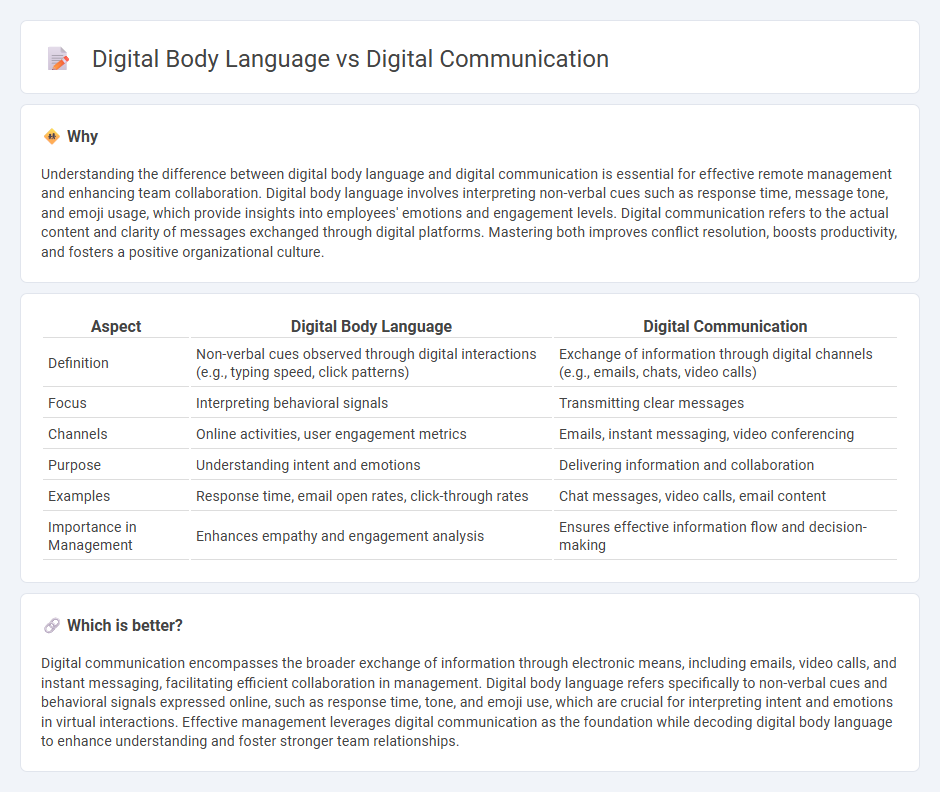
Digital body language encompasses non-verbal cues such as typing speed, response time, and emoji usage that reveal emotions and intentions in online interactions. Digital communication involves the exchange of information through emails, instant messaging, and video calls, focusing on clarity and message delivery. Explore how mastering digital body language can enhance effective digital communication in modern management.
Why it is important
Understanding the difference between digital body language and digital communication is essential for effective remote management and enhancing team collaboration. Digital body language involves interpreting non-verbal cues such as response time, message tone, and emoji usage, which provide insights into employees' emotions and engagement levels. Digital communication refers to the actual content and clarity of messages exchanged through digital platforms. Mastering both improves conflict resolution, boosts productivity, and fosters a positive organizational culture.
Comparison Table
| Aspect | Digital Body Language | Digital Communication |
|---|---|---|
| Definition | Non-verbal cues observed through digital interactions (e.g., typing speed, click patterns) | Exchange of information through digital channels (e.g., emails, chats, video calls) |
| Focus | Interpreting behavioral signals | Transmitting clear messages |
| Channels | Online activities, user engagement metrics | Emails, instant messaging, video conferencing |
| Purpose | Understanding intent and emotions | Delivering information and collaboration |
| Examples | Response time, email open rates, click-through rates | Chat messages, video calls, email content |
| Importance in Management | Enhances empathy and engagement analysis | Ensures effective information flow and decision-making |
Which is better?
Digital communication encompasses the broader exchange of information through electronic means, including emails, video calls, and instant messaging, facilitating efficient collaboration in management. Digital body language refers specifically to non-verbal cues and behavioral signals expressed online, such as response time, tone, and emoji use, which are crucial for interpreting intent and emotions in virtual interactions. Effective management leverages digital communication as the foundation while decoding digital body language to enhance understanding and foster stronger team relationships.
Connection
Digital body language, encompassing nonverbal cues such as typing speed, emoji use, and message response time, plays a crucial role in enhancing digital communication by conveying emotions and intentions otherwise lost in text-based interactions. Effective management leverages this understanding to interpret team sentiment, foster engagement, and reduce misunderstandings in remote or hybrid work environments. Integrating digital body language insights into communication strategies improves collaboration, trust, and overall organizational productivity.
Key Terms
Channel Richness
Digital communication relies on various channels such as email, video calls, and instant messaging, each differing in channel richness based on the immediacy and clarity of the transmitted information. Digital body language involves interpreting non-verbal cues within these channels, where richer mediums like video calls provide more nuanced signals through facial expressions and gestures. Explore how channel richness impacts understanding and engagement in digital interactions for deeper insights.
Nonverbal Cues
Digital communication encompasses all forms of exchanging information electronically, while digital body language specifically refers to interpreting nonverbal cues such as emojis, response time, and message tone in online interactions. Understanding digital body language enhances clarity and emotional connection by decoding subtle signals that often go unnoticed in text-based communications. Explore how mastering these nuances can improve your virtual relationships and professional exchanges.
Message Interpretation
Digital communication encompasses all electronic exchanges of information, including emails, texts, and video calls, while digital body language refers to the non-verbal cues expressed through online behavior such as response time, tone, and emoji usage. Message interpretation in digital communication relies heavily on context and clarity, whereas understanding digital body language requires analyzing behavioral patterns to infer emotions and intent. Explore how mastering both digital communication and digital body language can enhance your message interpretation skills in virtual environments.
Source and External Links
Digital Communication: what is it? - Digital communication is the transfer of data or information using digital signals over channels like fiber optics or wireless networks, connecting devices and people globally with minimal manpower.
Digital Communication: What It Is and Where It's Headed - Digital communication refers to the electronic exchange of messages, data, or information through mediums such as email, instant messaging, video calls, social media, and chatbots.
Data communication - Wikipedia - Digital communication involves transferring discrete messages or digitized analog signals over various channels, including wireless, optical, and wired networks, using methods like pulse-code modulation and digital modulation.
 dowidth.com
dowidth.com